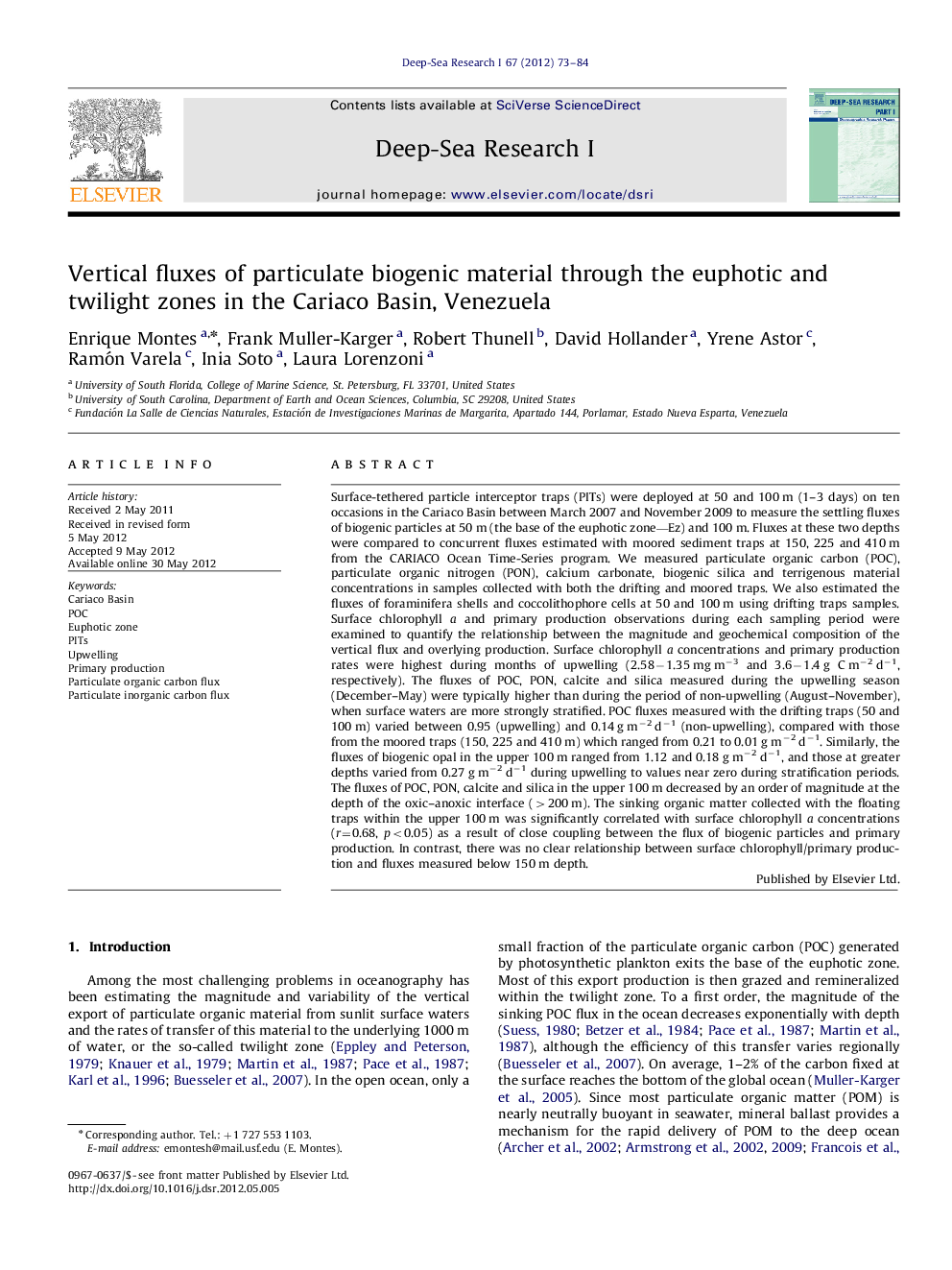| کد مقاله | کد نشریه | سال انتشار | مقاله انگلیسی | نسخه تمام متن |
|---|---|---|---|---|
| 4534672 | 1626363 | 2012 | 12 صفحه PDF | دانلود رایگان |

Surface-tethered particle interceptor traps (PITs) were deployed at 50 and 100 m (1–3 days) on ten occasions in the Cariaco Basin between March 2007 and November 2009 to measure the settling fluxes of biogenic particles at 50 m (the base of the euphotic zone—Ez) and 100 m. Fluxes at these two depths were compared to concurrent fluxes estimated with moored sediment traps at 150, 225 and 410 m from the CARIACO Ocean Time-Series program. We measured particulate organic carbon (POC), particulate organic nitrogen (PON), calcium carbonate, biogenic silica and terrigenous material concentrations in samples collected with both the drifting and moored traps. We also estimated the fluxes of foraminifera shells and coccolithophore cells at 50 and 100 m using drifting traps samples. Surface chlorophyll a and primary production observations during each sampling period were examined to quantify the relationship between the magnitude and geochemical composition of the vertical flux and overlying production. Surface chlorophyll a concentrations and primary production rates were highest during months of upwelling (2.58−1.35 mg m−3 and 3.6−1.4 g C m−2 d−1, respectively). The fluxes of POC, PON, calcite and silica measured during the upwelling season (December–May) were typically higher than during the period of non-upwelling (August–November), when surface waters are more strongly stratified. POC fluxes measured with the drifting traps (50 and 100 m) varied between 0.95 (upwelling) and 0.14 g m−2 d−1 (non-upwelling), compared with those from the moored traps (150, 225 and 410 m) which ranged from 0.21 to 0.01 g m−2 d−1. Similarly, the fluxes of biogenic opal in the upper 100 m ranged from 1.12 and 0.18 g m−2 d−1, and those at greater depths varied from 0.27 g m−2 d−1 during upwelling to values near zero during stratification periods. The fluxes of POC, PON, calcite and silica in the upper 100 m decreased by an order of magnitude at the depth of the oxic–anoxic interface (>200 m). The sinking organic matter collected with the floating traps within the upper 100 m was significantly correlated with surface chlorophyll a concentrations (r=0.68, p<0.05) as a result of close coupling between the flux of biogenic particles and primary production. In contrast, there was no clear relationship between surface chlorophyll/primary production and fluxes measured below 150 m depth.
► We measure biogenic particulate fluxes at several depths in the Cariaco Basin.
► We examine the transfer of biogenic material from the euphotic zone to greater depths.
► We also analyze seasonal patterns of the flux linked to changes in primary production.
► Most of sinking organic matter is respired within the upper 200 m of the water column.
► Biogenic fluxes in the upper 100 m are correlated with surface chlorophyll concentration.
Journal: Deep Sea Research Part I: Oceanographic Research Papers - Volume 67, September 2012, Pages 73–84